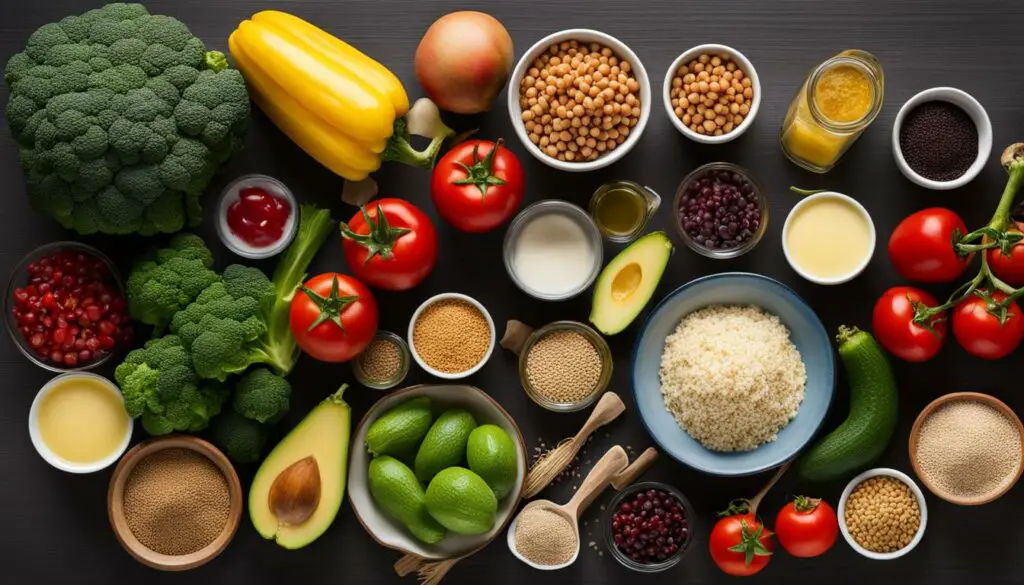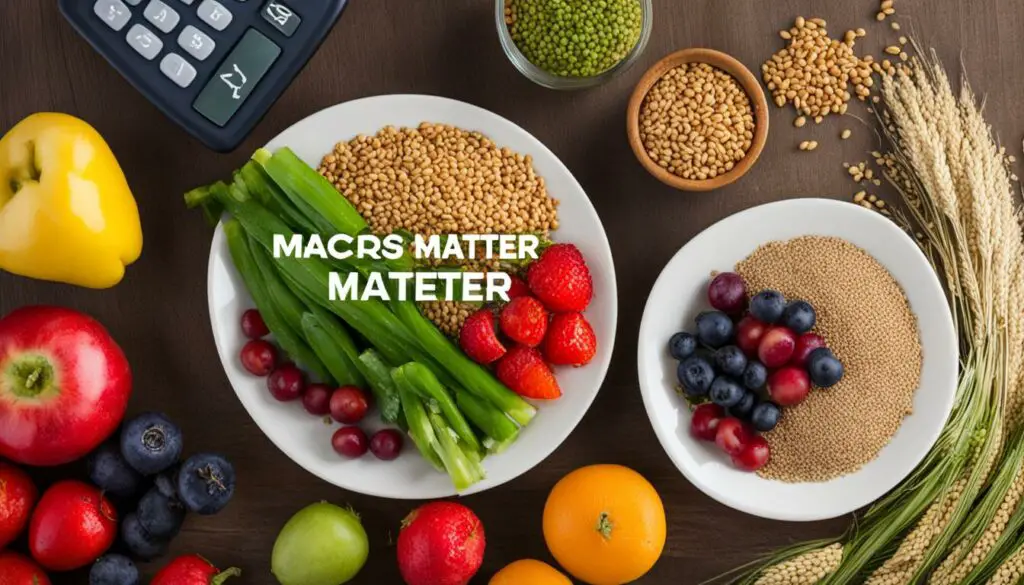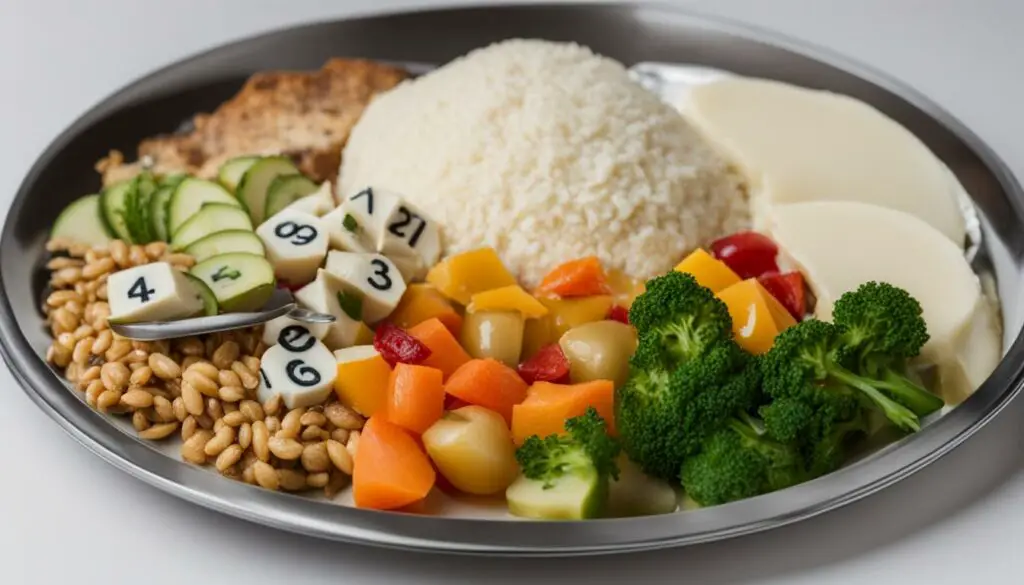Are you looking to make healthier choices in your cooking? Or perhaps you’re following a specific diet plan that requires you to track your nutrition intake. Whatever your reasons may be, learning how to calculate macros in a recipe is an essential skill for any home cook or aspiring chef.
In this comprehensive guide, we’ll walk you through the process of accurately calculating macros in your homemade dishes. With our step-by-step instructions and helpful tips, you’ll be able to easily track and adjust the nutritional values of your meals to meet your specific health and fitness goals.
Contents
- 1 Why Calculate Macros in Recipes?
- 2 Understanding Macronutrients
- 3 Gathering Recipe Information
- 4 Calculating Macros per Ingredient
- 5 Recording Macros for the Recipe
- 6 Adjusting Macros in Recipes
- 7 Tips for Easier Macro Calculation
- 8 Importance of Regular Macro Tracking
- 9 Exploring Macro-Friendly Recipes
- 10 Conclusion
- 11 FAQ
Key Takeaways:
- Calculating macros in a recipe is essential for individuals looking to achieve specific fitness goals or meet certain dietary requirements.
- Macronutrients refer to the three main components of our diet: carbohydrates, proteins, and fats.
- To calculate the macros in a recipe, you’ll need to gather information on the ingredients and their nutritional values.
- Tracking macros in homemade meals is an important habit to develop to stay accountable and consistently meet your nutritional needs.
- There are countless macro-friendly recipes available that align with different macro ratios for you to experiment with.
Why Calculate Macros in Recipes?
Before we dive into the details of calculating macros in a recipe, let’s take a closer look at the importance of this task. By calculating macros, you can gain valuable insights into the nutritional content of your meals. This information is essential for individuals looking to achieve specific fitness goals, manage their weight, or meet certain dietary requirements. Knowing the macronutrient breakdown of a recipe allows you to make informed choices about the foods you consume and ensure that your meals align with your nutritional needs.
Calculating nutritional values in a recipe involves determining the calorie, carbohydrate, protein, and fat content of each ingredient in the recipe. Once you have this information, you can add up the total nutritional values for the entire recipe. This will give you a better understanding of the overall nutritional content of the dish, allowing you to make any necessary adjustments to meet your fitness goals.
Whether you’re looking to lose weight, gain muscle, or simply eat a balanced diet, tracking your macros is essential. By understanding the macronutrient breakdown of the foods you consume, you can make more informed choices and ensure that your diet aligns with your health and nutrition goals.
Why Tracking Macros is Important for Fitness Enthusiasts
If you’re a fitness enthusiast, tracking your macros is especially important. This is because the macronutrient ratios in your diet can have a significant impact on your performance and results. For instance, if you’re looking to build muscle, you’ll need to consume a higher amount of protein to support muscle growth. On the other hand, if you’re trying to lose weight, you may want to focus on reducing your carbohydrate intake to help you achieve a calorie deficit.
Understanding the macronutrient breakdown of your meals can also help you optimize your pre and post-workout nutrition. For example, consuming a meal high in carbohydrates and protein before a workout can provide you with the energy and nutrients you need to power through your training session. Similarly, consuming protein after a workout can help your muscles recover and grow.
Why Tracking Macros is Important for Those with Dietary Restrictions
If you have dietary restrictions or follow a specific diet plan, tracking macros is essential to make sure you’re meeting your nutritional needs. For example, individuals following a vegan or vegetarian diet may need to pay extra attention to their protein intake to make sure they’re getting enough of this essential nutrient. Similarly, individuals with celiac disease or gluten intolerance will need to be mindful of the carbohydrate and protein content of their meals to avoid consuming gluten-containing grains.
By tracking your macros, you can ensure that your meals align with your dietary needs and preferences. This can help you stay on track with your nutrition goals and maintain a balanced, healthy diet.
Understanding Macronutrients

To calculate macros in a recipe, it’s crucial to have an understanding of macronutrients. Macronutrients are the three main components of our diet: carbohydrates, proteins, and fats.
Carbohydrates: Carbohydrates are the primary source of energy for our bodies. They are found in foods like grains, fruits, and vegetables. One gram of carbohydrates has four calories.
Proteins: Proteins are essential for building and repairing muscles, bones, and other tissues. They are found in foods like meat, poultry, fish, beans, and tofu. One gram of protein has four calories.
Fats: Fats play a crucial role in healthy brain function and hormone production. They also provide insulation for our organs and help us absorb vitamins. Fats are found in foods like avocado, nuts, cheese, and oils. One gram of fat has nine calories.
Each macronutrient has a specific calorie value, and by knowing the calorie content of each macronutrient, we can determine the overall nutritional composition of a recipe.
Macro Breakdown for Recipes
A macro breakdown for a recipe refers to the percentage of calories contributed by each macronutrient. By knowing the macro breakdown of a recipe, we can determine its nutritional value and ensure it aligns with our health and fitness goals.
For example, a recipe with a macro breakdown of 40% carbohydrates, 30% proteins, and 30% fats would be suitable for a balanced diet, while a recipe with a macro breakdown of 10% carbohydrates, 70% proteins, and 20% fats would be more suitable for a high-protein, low-carb diet.
To calculate the macro breakdown of a recipe, we need to first calculate the macros for each ingredient, as outlined in section 5. We then add all the macros for the ingredients to obtain the total macros for the recipe. Finally, we divide each macronutrient’s total calories by the total calorie count of the recipe to obtain the macro breakdown.
Gathering Recipe Information
![]()
Before you can start tracking your macros in homemade meals, you need to gather important information about the recipe you plan to prepare. Start by creating a list of all the ingredients you plan to use, along with their specific quantities. It’s essential to measure ingredients accurately with the help of a food scale for better macro tracking in meal planning.
Once you’ve compiled the ingredient list, you’ll need to identify the nutritional values of each ingredient. Most packaged foods come with nutrition labels that provide this information. For fresh produce or other specialty items, you may need to use online resources to find the nutritional information. Ensure you’re tracking macros in homemade meals with reliable information.
In addition to the ingredient list and nutrition information, you’ll also need to know the total quantity of the recipe you’re preparing. This will help you determine the amount of each ingredient to use. Knowing the serving size is equally important to calculate the macros per serving.
Tracking Macros in Meal Planning
Tracking macros in meal planning is essential for individuals who want to manage their nutritional intake effectively. By tracking macros in homemade meals, you can ensure that you’re consuming the right amount of each macronutrient to meet your specific goals. You can track macros by creating a spreadsheet or using a nutrition-tracking app that can calculate macros for you automatically.
One important thing to note is that it’s essential to track your macros consistently and accurately. This means using the same measuring tools and checking nutritional labels every time. Tracking macros in meal planning is an ongoing process that requires attention to detail.
Calculating Macros per Ingredient

Calculating macros in a recipe requires a bit of math, but with our step-by-step guide, you’ll be able to do it with ease. Here’s how to calculate macros per ingredient:
| Step | Formula | Example |
|---|---|---|
| Calculate total calories per ingredient | Serving size x calories per serving | 1 cup of quinoa (185g) x 222 calories per serving = 408.3 calories |
| Calculate percentage of calories from carbs | Calories from carbs / total calories x 100 | 39g carbs x 4 calories per gram / 408.3 total calories x 100 = 38% |
| Calculate percentage of calories from protein | Calories from protein / total calories x 100 | 8g protein x 4 calories per gram / 408.3 total calories x 100 = 8% |
| Calculate percentage of calories from fat | Calories from fat / total calories x 100 | 6g fat x 9 calories per gram / 408.3 total calories x 100 = 13% |
Once you have determined the macronutrient breakdown for each ingredient, you can then multiply these percentages by the total amount of each ingredient used in the recipe to find the macros contributed by each ingredient.
Calculating macros per ingredient may seem daunting at first, but once you get the hang of it, it becomes second nature. And remember, knowledge is power when it comes to making informed choices about your nutrition.
Recording Macros for the Recipe

After calculating the macros for each ingredient, it’s time to record them for the recipe as a whole. To do this, you can create a table that outlines the macronutrient breakdown of the dish. Here’s an example:
| Macronutrient | Calories per Gram | Grams per Serving | Total Calories per Serving |
|---|---|---|---|
| Carbohydrates | 4 | 30 | 120 |
| Proteins | 4 | 20 | 80 |
| Fats | 9 | 10 | 90 |
| Total | 290 |
In this example, the recipe contains 30 grams of carbohydrates, 20 grams of proteins, and 10 grams of fats per serving. The total calorie count per serving is 290 calories.
Creating a table like this makes it easy to track the macros in your recipe and adjust them if necessary. You can also use this information to calculate the macros per serving if you’re meal prepping or tracking your daily intake.
So, take the time to record the macros for your homemade dishes. It may seem like an extra step, but it’s worth it to ensure that you’re meeting your nutritional goals.
Adjusting Macros in Recipes

Understanding macro ratios in cooking is essential for adjusting macros in recipes according to your specific goals. For instance, if you’re following a low-carb diet, you may want to reduce the amount of carbohydrates and increase the amounts of proteins and fats. The ideal macro ratios for your health or fitness goals will vary depending on your individual needs and preferences.
Generally, a balanced macro ratio is 40% carbohydrates, 30% proteins, and 30% fats. However, certain diets, such as the ketogenic diet, may require a higher fat intake and lower carbohydrate intake. It’s important to consult with a nutritionist or dietitian to determine the optimal macro ratio for your goals.
Adjusting Macros in a Recipe Example
| Ingredient | Quantity | Calories per serving | Carbohydrates per serving | Proteins per serving | Fats per serving |
|---|---|---|---|---|---|
| Chicken breast | 6 oz | 160 | 0g | 31g | 3g |
| Broccoli | 1 cup | 55 | 10g | 4g | 1g |
| Brown rice | 1 cup cooked | 218 | 45g | 5g | 1.8g |
In this example, a person following a low-carb diet may want to reduce the amount of brown rice in the recipe and increase the amount of chicken breast and broccoli. By making these adjustments, the recipe will have a higher protein and lower carbohydrate content, which aligns with low-carb diet goals.
Tips for Easier Macro Calculation

Counting macros in cooking can seem like a daunting task, but there are several tips that can make it easier.
- Use a food scale: Measuring ingredients accurately is essential for tracking macros. A food scale ensures you are using the exact amount of each ingredient, resulting in more accurate calculations.
- Utilize online resources: There are countless online recipe calculators and nutrition apps that can automatically calculate macros for you. These tools can save time and make macro tracking more convenient.
- Meal prep: Preparing meals in advance not only saves time but also makes it easier to track macros throughout the week. By prepping macro-friendly meals, you can ensure you’re meeting your nutritional needs without the stress of calculating macros every day.
By following these tips, you can make macro tracking an easy and manageable part of your meal planning routine. Remember, consistency is key when it comes to meeting your nutritional goals.
Importance of Regular Macro Tracking
![]()
Tracking macros in homemade meals is an essential step towards achieving your health and fitness goals. By regularly recording your macro intake, you can ensure that you’re meeting your nutritional needs and making progress towards your objectives.
Regular macro tracking also allows you to:
- Maintain accountability for your meals
- Identify areas of improvement in your diet
- Adjust your macro intake to align with your goals
One effective way to track your macros is by using a food diary or a dedicated nutrition-tracking app. By recording the macros of the meals you make at home, you can gain a better understanding of the nutritional content of different foods and make more informed choices.
Sample Macro Tracking Table:
| Meal | Carbohydrates | Proteins | Fats | Total Calories |
|---|---|---|---|---|
| Breakfast | 25g | 20g | 10g | 315 |
| Lunch | 30g | 25g | 12g | 385 |
| Dinner | 20g | 30g | 18g | 390 |
As you can see from the sample tracking table above, recording your macros can be both informative and visually engaging. It provides an overview of the macronutrient breakdown of each meal and allows you to adjust your diet accordingly.
By making macro tracking a regular habit, you can gain control over your nutritional intake and make healthier choices in the long run. Incorporating a variety of macro-friendly recipes into your meal planning can also make the process more enjoyable and sustainable.
Exploring Macro-Friendly Recipes

Now that you know how to calculate macros in a recipe, it’s time to put that knowledge into practice with some delicious macro-friendly recipes. These recipes are designed to align with specific macro ratios, ensuring that you can enjoy a satisfying and nutritious meal while still meeting your nutritional needs.
1. High-Protein Breakfast Bowl
This breakfast bowl is packed with protein to kickstart your day. Start with a base of quinoa and top with sautéed spinach, roasted sweet potatoes, and a poached egg. The quinoa provides slow-burning carbs, while the spinach and sweet potatoes offer fiber and vitamins. The egg adds a protein boost to keep you full all morning.
2. Low-Carb Cauliflower Fried Rice
This low-carb version of a classic Chinese dish is made with riced cauliflower instead of rice. Simply pulse the cauliflower in a food processor until it resembles rice, then sauté with diced vegetables and a protein of your choice. This dish is high in fiber and low in carbs, making it a great choice for anyone following a low-carb or keto diet.
3. Mediterranean Chicken Bowl
This Mediterranean-inspired recipe combines lean chicken breast, quinoa, roasted vegetables, and a tangy tzatziki sauce. The chicken provides a healthy dose of protein, while the quinoa and vegetables offer fiber and vitamins. The tzatziki sauce adds flavor and a boost of healthy fats.
4. Vegan Lentil Chili
This hearty chili is perfect for a cozy night in. It’s made with protein-rich lentils, diced tomatoes, and an array of warming spices. Top with avocado or a dollop of vegan sour cream for added creaminess. This recipe is vegan and gluten-free, making it a great option for anyone with dietary restrictions.
5. Protein-Packed Smoothie Bowl
This smoothie bowl is a great option for a post-workout snack or a refreshing breakfast. Blend together frozen berries, Greek yogurt, almond milk, and a scoop of protein powder. Top with granola and fresh fruit for added texture and nutrition.
These macro-friendly recipes are just the beginning of what you can create with your newfound knowledge of macro calculation in recipes. Get creative and experiment with different ingredient combinations to find new and delicious meals that align with your nutritional needs. Happy cooking!
Conclusion
Now that you have learned how to calculate macros in a recipe, you can take control of your nutrition and make healthier choices. By tracking your macros, you can adjust your meals to align with your specific dietary requirements, fitness goals, or weight management plan. Knowing the macronutrient breakdown of your meals will also help you make informed choices about your food intake.
Remember, gathering recipe information, calculating macros per ingredient, and recording macros for the entire recipe are essential steps in the process. Regular macro tracking is also important to stay on target with your nutrition goals. Don’t forget to explore macro-friendly recipes to add variety to your meal planning.
By incorporating the tips and techniques provided in this guide into your meal preparation, you can easily calculate macros in recipes and make every meal a healthy one. So, start applying these techniques today and take the first step towards a healthier lifestyle!
FAQ
How do I calculate macros in a recipe?
To calculate macros in a recipe, you need to gather the necessary information such as the list of ingredients, their quantities, and their nutritional values. Then, calculate the total calories in each ingredient, determine the percentage of calories contributed by each macronutrient (carbohydrates, proteins, and fats), and multiply the percentages by the total amount of the ingredient used in the recipe to find the macros contributed by each ingredient. Finally, record the macros for each ingredient and add them up to determine the total macros for the recipe.
Why is it important to calculate macros in recipes?
Calculating macros in recipes is important because it allows you to gain a better understanding of the nutritional content of your meals. This information is crucial for individuals looking to achieve specific fitness goals, manage their weight, or meet certain dietary requirements. By knowing the macronutrient breakdown of a recipe, you can make informed choices and ensure that your meals align with your nutritional needs.
What are macronutrients?
Macronutrients refer to the three main components of our diet: carbohydrates, proteins, and fats. Each macronutrient plays a unique role in our body’s functions and has a specific calorie value. By knowing the calorie content of each macronutrient, you can determine the overall nutritional composition of a recipe.
How can I adjust macros in recipes?
Calculating macros in a recipe allows you to adjust them according to your specific goals. For instance, if you’re following a low-carb diet, you can reduce the amount of carbohydrates in the recipe and increase the amounts of proteins and fats. Understanding the ideal macro ratios for your health or fitness goals helps you tailor recipes to suit your needs.
How often should I track macros in homemade meals?
Tracking macros in homemade meals should be a regular habit, especially if you have specific health or fitness goals. Regular tracking allows you to stay accountable and make adjustments as necessary to ensure you’re consistently meeting your nutritional needs. It also helps you develop a better understanding of the nutritional content of different foods and make more informed choices.
Are there any tips for easier macro calculation?
Yes, there are a few tips to make macro calculation easier. Firstly, use a food scale to measure ingredients accurately. Secondly, make use of online recipe calculators and nutrition apps that can automatically calculate macros for you. Additionally, consider meal prepping and batch cooking to save time and easily track macros throughout the week.









